Urban Farming in Richmond: Insights and Future Directions


Topic Overview
Definition and Importance
Urban farming refers to cultivating, processing, and distributing food in or around urban areas. It encapsulates a wide range of activities that contribute not only to food production but also to community resilience and ecological well-being. The importance of urban farming cannot be overstated—especially as cities grapple with rapid population growth, climate change, and food security challenges. By integrating green spaces into urban settings and fostering local food systems, cities like Richmond are making strides toward sustainable living and healthier communities.
Brief History and Evolution
Richmond's journey into urban farming is reflective of broader societal shifts toward sustainability. In the early 20th century, the city faced food scarcity during the Great Depression, leading to initiatives that encouraged backyard gardens—a precursor to modern urban agriculture. In later decades, as industrialization took hold, much of Richmond's farmland was lost to urban sprawl. However, as communities began to recognize the benefits of local food production, the tide started to turn. Today, urban farming in Richmond is thriving, fueled by innovative grassroots movements and supportive policies that underscore its value in promoting environmental awareness and community engagement.
Key Techniques and Innovations
Sustainable Farming Practices
Sustainable practices are at the heart of Richmond's urban agriculture landscape. Techniques like permaculture, aquaponics, and vertical farming are gaining traction. For instance, many urban farmers in Richmond employ permaculture principles to create self-sustaining ecosystems that minimize waste and enhance biodiversity. Additionally, urban gardens are often designed to use rainwater harvesting systems, reducing dependence on municipal water supplies and demonstrating how water conservation can be integrated into farming practices.
Advanced Agronomic Technologies
Innovation plays a significant role in urban farming, with technology enhancing productivity and efficiency. The use of sensors for soil moisture levels, automated irrigation systems, and mobile applications for farmers to track crop health are changing the game. For example, farmers in Richmond are experimenting with software that predicts optimal planting times based on weather patterns, helping them make informed decisions. These technologies allow urban farmers to maximize their yield while minimizing environmental impact, solidifying Richmond's position as a leader in urban agriculture.
Practical Applications
Step-by-Step Guides
For those eager to dive into urban farming, starting small is often the best approach. Here is a brief guide to get you going:
- Choose Your Space: Identify your available space—whether it's a backyard, balcony, or community garden.
- Select Your Crops: Opt for crops that suit your climate and personal preferences. Leafy greens, tomatoes, and herbs are popular picks for beginners.
- Prepare the Soil: Ensure your soil is nutrient-rich; consider raised beds filled with quality soil if you're limited on ground space.
- Plant and Care: Follow planting guides for your chosen crops, and make sure to water and maintain them regularly.
- Harvest and Enjoy: Once your crops are ready, enjoy the fruits of your labor and share with neighbors to strengthen community ties.
Case Studies or Real-World Examples
Several community projects in Richmond stand out as exemplars of urban farming's potential. The Richmond Community Garden, for instance, has transformed an underutilized space into a flourishing garden that provides fresh vegetables to its members while offering educational workshops. Another noteworthy initiative, the Richmond Urban Agriculture Project, collaborates with local schools to teach students about the importance of food systems, sustainability, and healthy eating habits. These endeavors illustrate the profound impact urban farming can have, not just in terms of food production, but also in fostering community engagement and environmental awareness.
"Urban farming brings life back to the city, turning concrete jungles into green sanctuaries and revolutionizing the way we think about food."
For further reading about sustainable practices and urban farming across different cities, you can explore resources from the USDA at *.gov or delve into community discussions on platforms like reddit.com.
Exploring how these practices manifest and evolve in Richmond not only helps to illuminate the local culture but also serves as a beacon for other urban areas aiming to address food security and sustainability challenges.
Foreword to Urban Farming in Richmond
Urban farming, the practice of cultivating, processing, and distributing food in and around urban areas, has gained remarkable momentum in Richmond. It signifies a shift from traditional agricultural practices towards a more integrated approach to food production in urban environments. This article explores the nuances of urban farming in Richmond, shining a light on its historical context, current practices, and future potential.
One significant aspect of urban farming is its ability to create local food systems that reduce dependency on long supply chains. In a world increasingly faced with environmental challenges, food security concerns, and urbanization, Richmond's urban farms present a promising solution. Community members come together, growing fresh produce, herbs, and flowers right where they live, promoting not just sustainability, but also a stronger sense of community.
This article aims to provide a thorough understanding of how urban agriculture is reshaping food systems and fostering resilience within urban communities. By diving into the importance of the concept and examining Richmond's urban landscape, we will gain insights on the multifaceted nature of urban farming, making it imperative for readers interested in sustainable practices.
Concept and Importance of Urban Agriculture
At its core, urban agriculture represents more than just growing food in the city; it's a movement rooted in the goal of self-sufficiency and smart resource management. In a bustling urban environment like Richmond, urban agriculture tackles several pressing issues:
- Food Security: As communities strive to enhance their food security, urban farms provide accessible outlets for fresh produce.
- Environmental Sustainability: Incorporating green spaces into urban settings aids in reducing carbon footprints and encourages biodiversity.
- Community Well-Being: Urban farming acts as a catalyst for social interaction, allowing residents to bond over common goals of sustainability and health.
Supporting urban agriculture isn't just about producing food; it addresses broader social equity issues, environmental degradation, and the health of urban populations.
Richmond's Urban Landscape: A Brief Overview
Richmond's urban landscape offers a unique backdrop for urban farming. The city, with its valleys and river systems, provides ample opportunities for creative agricultural practices. Thinking of Richmond's neighborhoods, we see a mixture of historical and modern developments entwined. This blend enables the urban farmer to incorporate both traditional and innovative growing techniques.
Significant factors influencing Richmond’s urban agriculture practices include:
- Diverse Communities: Richmond is home to a melting pot of cultures. This diversity promotes an array of agricultural traditions and culinary preferences, enhancing the variety of what is grown in urban spaces.
- Strategic Partnerships: Collaboration between local governments, non-profits, and community groups helps facilitate the establishment of community gardens and urban farms. Such partnerships are essential for resource sharing and educational outreach.
- Urban Infrastructure: The availability of under-utilized spaces such as rooftops, vacant lots, and parks in Richmond provides fertile ground for creative farming solutions.
Richmond's evolution as an urban farming hub is not just a fleeting trend. It is a reflection of changing societal values towards health, sustainability, and community empowerment.
Historical Context of Urban Farming in Richmond
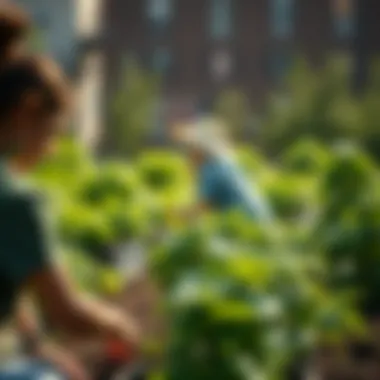

Understanding the historical context of urban farming in Richmond offers valuable insights into how and why it has evolved into a significant movement within the community. It lays the groundwork for appreciating current practices, successes, and ongoing challenges that local farmers face. Recognizing the rich tapestry of agricultural practices provides context to today's movements, showcasing old traditions alongside new innovations and highlighting the community's bond with the land.
Early Agricultural Practices
In the early days of Richmond, agriculture was a part of everyday life. Farmsteads peppered the landscape, where families grew vegetables like tomatoes, beans, and corn to sustain themselves. The proximity to the James River enhanced irrigation, making cultivation more feasible. These small-scale farmers relied heavily on the resources at hand, using techniques passed down through generations. Local markets flourished as communities engaged in barter or trade, which not only supported the economy but also fostered close-knit community ties. The spirit of sharing food and resources established values that resonate in contemporary urban farming practices.
One significant early practice involved the creation of kitchen gardens. Before supermarkets became ubiquitous, most households cultivated their gardens to supply fresh produce. This trend of growing food close to home nurtured self-sufficiency and brought neighbors together for communal effort.
Urban farming is not just about growing food; it's about growing community.
Evolution through the Decades
As the decades rolled on, the landscape of Richmond transformed markedly. The post-war boom in the 1950s and 1960s revealed a surge in urbanization. With this shift, many farmfields were replaced by concrete structures and suburbs sprouted up like wildflowers. Despite this, remnants of agricultural practices lingered and began to adapt to urban settings. In the 1970s, a resurgence of interest in organic gardening emerged, influenced by the counterculture movement, and paved the way for a growing awareness of health and sustainability.
In the 1980s and 1990s, city planners and community advocates began to recognize the potential of derelict spaces as venues for urban agriculture. The advent of community gardens in neighborhoods brought new life to once-neglected areas and offered locals a chance to reconnect with the land. One prominent example is the creation of the Richmond Community Garden project which transformed vacant lots into green spaces where community members could cultivate not just plants, but relationships as well.
More recently, the 2000s have marked a turning point for urban farming in Richmond, with an explosion of interest in innovative farming methods like hydroponics and vertical farming. Local initiatives, driven by citizens looking to provide fresh food to the inner city, highlight an increasing emphasis on sustainability. This decade has seen the rise of technology's integration into agriculture, where apps and smart devices help farmers monitor crops with precision, ensuring resource efficiency and reducing waste.
Thus, the evolution of urban farming in Richmond is a tale of resilience, adaptation, and community spirit that mirrors societal changes and environmental consciousness. As we look ahead, these historical insights pave the way to understanding the challenges and opportunities that will shape the future landscape of urban agriculture.
Current Urban Farming Practices
Urban farming has become a significant aspect of Richmond's landscape, offering fresh produce and fostering community connections. These practices bridge gaps in local food systems and promote healthier lifestyles for residents. This section will explore the various types of urban farms, the community gardens that dot the city, and the innovative vertical farming methods that have emerged.
Types of Urban Farms in Richmond
Richmond boasts a vibrant array of urban farming types, each catering to different community needs and environmental goals. The types include:
- Market Gardens: Often smaller in scale, these farms focus on cultivating high-value crops for direct sale to consumers. They contribute economically by keeping money local and reducing food miles.
- Rooftop Farms: These bustling green spaces make clever use of the city’s rooftops, transforming unused areas into productive plots. They not only produce food but help insulate buildings and manage rainwater runoff.
- Allotment Gardens: Individuals can rent small plots of land to grow their vegetables and herbs. This model engages residents and promotes self-sufficiency.
Each type has its own benefits and plays a role in promoting food security while encouraging sustainable practices.
Community Gardens and Shared Spaces
Community gardens are at the heart of Richmond's urban farming movement. They serve as spaces for residents to collaborate, share knowledge, and cultivate plants together. These shared gardens offer numerous advantages:
- Social Cohesion: Neighbors frequently meet, share ideas, and work side by side in the soil, fostering friendships and community spirit.
- Educational Opportunities: Many gardens host workshops on topics like organic farming, composting, and pest management, empowering participants to adopt sustainable practices.
- Access to Fresh Produce: Community gardens ensure that even in urban settings, residents can access nutritious food options at little to no cost.
These gardens exemplify how urban farming can create vibrant social networks while addressing food insecurity. > "Community gardens not only provide food but cultivate relationships and educational growth."
Vertical Farming Innovations
Vertical farming has gained traction in Richmond, revolutionizing the way food is grown in densely populated areas. By stacking crops in vertically inclined spaces, urban farmers maximize their yield without requiring expansive land.
- Space Efficiency: Vertical farming allows for a significant increase in crop production per square foot, ideal for urban environments where land is scarce.
- Resource Management: Many vertical farms utilize hydroponics or aeroponics systems, which use less water than traditional farming methods, making them more environmentally sustainable.
- Year-Round Production: Indoor vertical farms can maintain optimal growing conditions regardless of seasonal changes, leading to consistent food supply throughout the year.
This innovative approach not only addresses the challenges posed by urban living but also plays a crucial role in reducing the carbon footprint associated with food transportation.
In summary, the current urban farming practices in Richmond showcase a spectrum of methods and communal efforts. These practices are not just about producing food; they symbolize a shift towards sustainability, community engagement, and resilience in the face of urban challenges.
Benefits of Urban Farming
Urban farming is not just a trend, it’s a vital response to an array of contemporary challenges facing cities. Understanding the benefits of urban farming offers insights into why this practice is essential for communities like Richmond. This section explores three key areas where urban agriculture shines: enhancing food security, promoting sustainability and biodiversity, and fostering community engagement through education.
Enhancing Food Security
Food security is a growing concern in urban areas. As cities expand, access to fresh produce can diminish. Urban farming directly addresses this by increasing the availability of fresh, healthy food options within the city. By growing crops locally, urban farms reduce the distance food travels, minimizing transportation emissions and costs. Furthermore, when residents can access nutritious food nearby, the reliance on processed foods decreases, leading to improved health outcomes.
"Urban farms can serve as community lifelines, providing access to fresh produce right at people's doorsteps."
In Richmond, community-supported agriculture (CSA) programs aid in this mission by connecting urban farmers with local consumers. For example, a typical Richmond CSA might allow subscribers to receive boxes of seasonal produce direct from local farmers each week. This not only fosters a direct connection between producers and consumers but also strengthens local economies.
Promoting Sustainability and Biodiversity
Sustainability is a core principle of urban farming. These farms utilize innovative techniques, such as permaculture and organic practices, which promote environmental health. Unlike conventional farming that often depletes soil nutrients, urban farms focus on regenerative methods that enrich the soil over time. This shifts the paradigm from simply extracting resources to nurturing them.
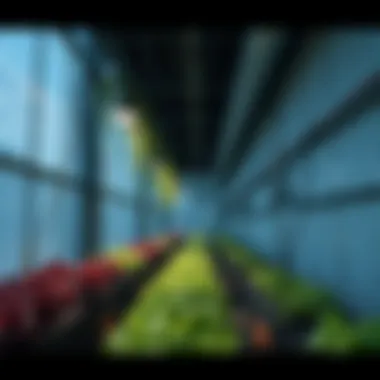
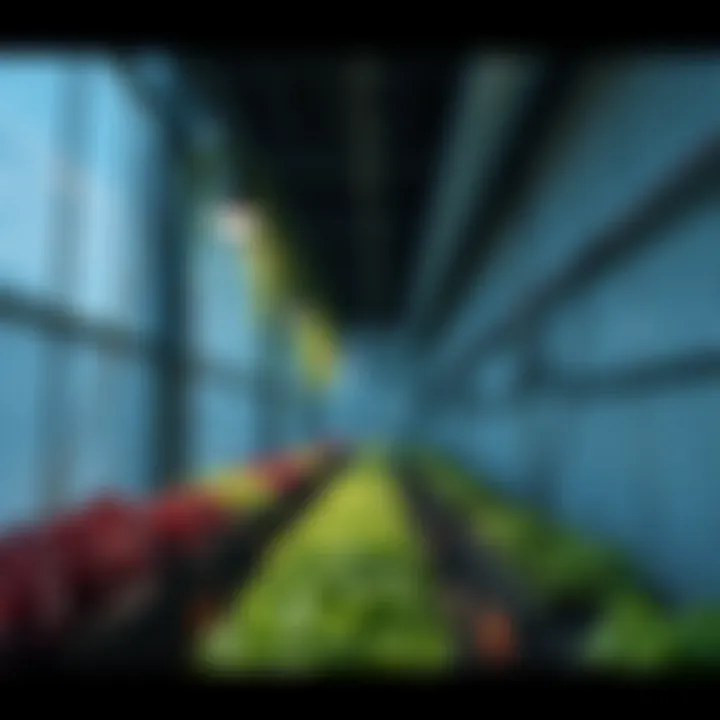
Biodiversity thrives in urban setups. By incorporating a variety of plants, urban farms create habitats for pollinators like bees and butterflies. The Richmond community has seen many initiatives to encourage planting diverse crops, thereby increasing not only the resilience of the local food system but also enriching the urban ecosystem. In these urban green spaces, gardeners often mix vegetables with native plants to support wildlife while providing food sources.
Community Building and Education
Urban farming goes beyond food production; it acts as a social glue that binds communities together. Community gardens often double as educational platforms, where residents gather to learn about sustainable gardening practices, nutrition, and environmental stewardship. Workshops may cover topics ranging from composting to cooking classes that highlight utilizing local produce.
Moreover, engaging in these practices helps foster a sense of ownership and pride among residents. People come together to share knowledge, resources, and support, creating a vibrant network that extends beyond gardening.
As Richmond continues to expand its urban farming initiatives, it’s essential to prioritize these educational aspects. They allow the community to evolve, creating not just growers but informed and empowered citizens who care about their environment and their neighbors.
The benefits of urban farming are not just theoretical. They manifest in better health, a more sustainable environment, and strengthened community ties—all crucial for the fabric of Richmond's society. The shift toward urban agriculture thus represents a key step in rethinking how we produce and consume food in urban settings, ensuring that cities can thrive both now and in the future.
Challenges Facing Urban Farmers
Urban farming in Richmond, though a beacon of innovation and sustainability, doesn't come without its hurdles. These challenges shape the landscape of urban agriculture and dictate the plights, opportunities, and resilience of community farmers. Understanding these obstacles is essential for anyone looking to engage in or support urban farming initiatives.
Land Use and Zoning Regulations
One of the most significant challenges urban farmers encounter involves navigating the complex web of land use and zoning regulations. These rules can often appear more as friction than as support. Zoning laws may restrict the types of agriculture permissible in certain areas, leading to conflict between urban planners and farmers. In Richmond, some neighborhoods may be classified in ways that limit agricultural activities, creating a situation where entrepreneurs struggle to find suitable locations for their farms.
Furthermore, these regulations might seem necessary for maintaining order in a bustling urban environment, yet they can stifle creativity. Local ordinances often prioritize commercial developments over community gardens. Urban farmers have to become advocates not only for food sovereignty but also for policies that recognize farming as a legitimate use of urban space. This advocacy is crucial because it encourages both local governments and the community to rethink the way land is allocated and used.
Access to Resources and Funding
Access to resources is another considerable barrier for urban farmers. Whether it is land, water, or equipment, these essential elements are often hard to come by. Funding also plays a vital role. Many urban farms rely on grants, local donations, or community investment initiatives, which can be inconsistent. Without a reliable stream of funding, farmers may succumb to the financial burden that can accompany urban agriculture.
A farmer’s success is typically measured not just in crops but also in the resources they can secure.
In Richmond, numerous organizations aim to support urban farms. These include local nonprofits and government agencies that aspire to foster community growth and sustainability. However, urban farmers often feel overwhelmed by the multitude of programs, each with its own criteria for application and very particular guidelines. Simplifying access to these resources could enhance participation and ultimately contribute to the agricultural diversity Richmond seeks to achieve.
Climate and Environmental Concerns
Urban farming in Richmond also contributes to and is impacted by climate change. Urban areas generally suffer from increased temperatures and less available green space. Farmers in the city must deal with the unique problems posed by urban heat islands, which can affect crop yields. As climate patterns continue to shift, farmers may find it increasingly challenging to grow their crops under fluctuating weather conditions.
Moreover, environmental concerns, such as water quality and soil health, can vary drastically throughout the city. Contaminated soil or water runoff often leads to challenges that can compromise crop safety and productivity. For farmers dedicated to organic practices or sustainability, these issues pose an ethical dilemma.
As Richmond continues to develop, it becomes imperative to address these climate and environmental issues head-on. Education about sustainable practices and soil management, alongside improved environmental policies, could help build resilience in urban farming communities. Farmers must be prepared not only to adapt to these changing conditions but also to advocate for sustainable practices that could mitigate some environmental risks.
In summary, the challenges urban farmers face in Richmond—ranging from zoning laws to access to resources, and environmental pressures—require thoughtful approaches and collaborative efforts. By overcoming these barriers, urban farmers can enhance food production, community ties, and the overall health of urban ecosystems.
The Role of Technology in Urban Farming
The integration of technology in urban farming has revolutionized how cities approach food production. In Richmond, the role of technology cannot be overstated; it not only enhances efficiency but also paves the way for sustainable practices owing to the growing urban population. The harmony between agriculture and technology allows for increased yields, reduced resource usage, and a significant shift in how communities engage with food systems.
In urban environments where space is at a premium and environmental challenges are on the rise, modern technological solutions provide practical pathways for maintaining productivity. Farmers in Richmond are harnessing smart farming techniques and advanced hydroponic systems to sidestep traditional challenges associated with urban agriculture.
"The future of urban farming relies heavily on technology, bridging the gap between food supply and urban demand."
Smart Farming Techniques
Smart farming is an umbrella term that encompasses a range of technologies aimed at optimizing agricultural processes. Various strategies—such as the use of sensors, data analytics, and automation—are gaining traction among Richmond’s urban farmers. Utilizing Internet of Things (IoT) devices, farmers can monitor crop health in real-time. Sensors can measure soil moisture content, pH levels, and nutrient availability, allowing farmers to apply targeted interventions rather than broad-spectrum solutions that may exacerbate environmental concerns.
Furthermore, apps that track weather patterns and trends provide valuable insights that farmers use for planning planting and harvesting schedules. Smart irrigation systems, which adjust water usage based on weather forecasts and soil moisture levels, can significantly reduce waste while ensuring crops receive adequate hydration. Ultimately, integrating such technologies leads to a more resilient and responsive urban agriculture landscape in Richmond.
- Efficiency: By automating repetitive tasks, farmers can focus more on creativity and problem-solving.
- Precision: Data-driven decision-making enhances resource conservation, optimizing inputs and improving output quality.
- Adaptability: Farmers can mold their strategies based on detailed environmental data, making them more responsive to changes.
Hydroponics and Aquaponics
In Richmond, hydroponics and aquaponics are two popular techniques pushing the boundaries of urban farming. Hydroponics, the method of growing plants in a nutrient-rich water solution without soil, allows for cultivation in spaces where soil quality is poor or non-existent. This method can yield produce at a much faster rate than traditional farming methods, which is crucial in a fast-paced urban environment.
Aquaponics takes this a step further by integrating fish farming into the system. Essentially, it mimics a natural ecosystem where fish waste provides nutrients for plants. This symbiotic relationship creates a self-sustaining environment, reducing waste while producing both protein and vegetables. Richmond's own community gardens are beginning to adopt these innovative practices, showcasing how urban farmers are using technology not just to produce food, but to do so sustainably.
With the growing demand for local food sources, hydroponics and aquaponics tap into the potential for year-round farming, irrespective of outdoor climate conditions. Local farmers are increasingly seeing these methods as viable solutions that enhance productivity and provide fresh produce to Richmond's residents, diminishing reliance on external food supplies.
Community Engagement in Urban Farming
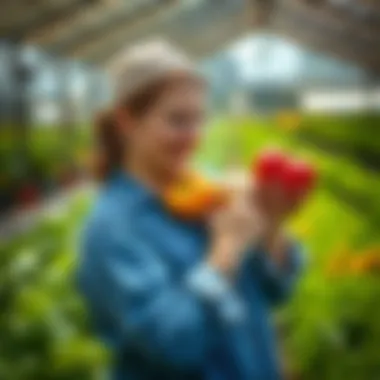
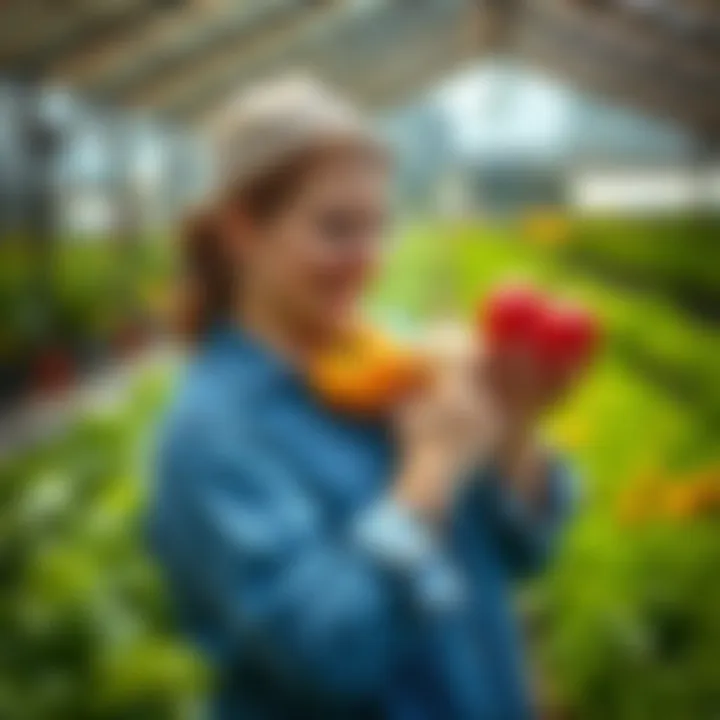
Community engagement is the heartbeat of urban farming in Richmond. It transforms simple growing endeavors into vibrant social movements, intertwining various threads of the community fabric. Engagement isn't just a nice-to-have perk; it's a necessity, one that creates connections, cultivates awareness, and ensures the sustainability of farming efforts. When individuals come together to work in the soil, they develop a sense of ownership and pride, leading to positive social change.
Urban farming in Richmond is not merely about growing vegetables or herbs; it’s about growing relationships and trust among residents. These farms often become communal gathering spots where people from different backgrounds converge, share knowledge, and establish networks. In doing so, they foster a spirit of cooperation, amplifying voices that might otherwise go unheard.
Educational Programs and Workshops
Educational programs and workshops are crucial in building this communal infrastructure. They serve as platforms to disseminate knowledge and skills, empowering residents to engage actively in urban farming initiatives. Richmond offers a variety of workshops, focusing on practical techniques such as composting, seed saving, and organic pest control.
Many local organizations, such as the Richmond Urban Farm Collective, provide regular workshops aimed at both novices and seasoned gardeners. These workshops include hands-on activities where participants can get their hands dirty while learning. It’s not all theory; attendees might find themselves planting seeds or setting up drip irrigation systems. This immersive learning experience is key to fostering confidence among new farmers.
Here are some highlights from typical educational offerings:
- Composting Workshops: Teach participants the science behind composting and how to create nutrient-rich soil at home.
- Cooking Demonstrations: Show how to prepare meals with fresh, local produce, emphasizing the benefits of eating seasonally and supporting community farmers.
- Sustainable Practices: Focus on methods that promote environmental health, such as permaculture principles and water conservation techniques.
- Youth Programs: Engage younger generations in urban farming, often featuring activities designed specifically for school groups. This also helps to develop tomorrow's environmentally conscious citizens.
Volunteer Opportunities and Contributions
Volunteering in urban farms presents an invaluable opportunity for Richmond residents to contribute to their community while gaining practical skills. These farms rely heavily on volunteers to maintain their gardens, run events, and organize educational activities. This makes volunteering a pivotal part of urban agricultural efforts in the area.
Local urban farms actively advertise opportunities for community involvement. They often create fun events, like harvest festivals or planting days, where anyone interested can lend a hand. These volunteer programs are designed not just to get labor but to foster a deeper connection to local food systems. By working the land, volunteers gain insights into where their food comes from, bridging the gap between city life and agricultural roots.
Aside from farm maintenance, volunteers can also contribute in different ways:
- Fundraising Activities: Helping to raise funds through events or initiatives that support local farms.
- Advocacy Work: Engaging with local government and organizations to promote policies beneficial to urban farming initiatives.
- Outreach: Spreading the word about available programs and how urban farming is impactful.
The contributions of volunteers extend beyond the physical aspects of farming; their engagement strengthens community ties and nourishes social cohesion.
"When we all come together to contribute our time and efforts, we create something much more significant than just vegetables. We grow community."
In summary, community engagement is essential for thriving urban farming in Richmond. Educational programs and volunteer opportunities not only empower individuals but also foster a sense of belonging and collective responsibility. As urban farming continues to grow in importance, so too does the role of each resident in nurturing a sustainable and interconnected community.
Future Prospects of Urban Farming in Richmond
The realm of urban farming in Richmond holds a tapestry of possibilities, reflecting both the challenges and innovations that are on the horizon. This phase in urban agriculture's journey is not just about growing food; it embodies a vision for a more sustainable and interconnected community. As population pressures continue to mount and environmental considerations grow in urgency, the future of urban farming in this city will hinge on strategic planning and community involvement.
Policy Development and Support
For urban farming to flourish, robust policy frameworks need to be established. Policymakers have an invaluable role in creating an environment conducive to urban agriculture. This involves zoning reforms that legalize farming practices in various areas, allowing for the integration of agricultural spaces within the urban fabric.
- Funding Opportunities: Support can also come in the form of grants and financial incentives aimed at urban farmers. Local governments can allocate funds for community gardens or urban farming projects, which not only stimulate the economy but enhance social cohesion.
- Technical Assistance: Providing technical support through workshops can empower new farmers. Training programs that delve into sustainable practices or innovative techniques can help novices develop their enterprises successfully.
- Regulatory Frameworks: Adopting regulations that facilitate easier access to land for urban farmers can decrease barriers faced by budding agriculturalists. It's essential that the dialogue between local government and these communities remain open to adapt as needs change.
A well-crafted policy can lead to a vibrant ecosystem of urban agriculture, enriching livelihoods and the broader community.
The Impact of Climate Change
Climate change looms large as a variable that will shape urban farming's future. The effects on crop cycles, soil health, and water availability are profound and must be factored into future strategies. Urban farmers in Richmond are particularly vulnerable to alterations in weather patterns, making adaptability crucial.
Here are several considerations:
- Resilience Strategies: Farmers are increasingly adopting techniques such as crop rotation and companion planting to improve yields and maintain soil fertility.
- Water Management Solutions: Implementing rainwater harvesting systems can mitigate reliance on municipal water sources, providing resilience against drought.
- Community Awareness Programs: Engaging local communities in climate awareness campaigns can lead to better support for sustainable practices, ensuring collective responsibility toward the environment.
Climate change may be a daunting hurdle, but with proactive approaches, Richmond's urban agriculture can not only survive but thrive, contributing to a more sustainable city.
"The best time to plant a tree was twenty years ago. The second best time is now." – Chinese Proverb
The future of urban farming in Richmond is not solely about individual plots and gardens, it's a collective movement towards reimaging urban spaces. As stakeholders across the board prioritize collaboration, education, and innovation, urban farming will undoubtedly find its place as a pillar of resilience, sustainability, and community engagement in Richmond.
Ending and Final Thoughts
Urban farming in Richmond not only represents a growing movement but echoes the aspirations for sustainability, community, and resilience. With the increasing challenges of food security and environmental changes, urban agriculture serves as a beacon of hope. This exploration highlights the journey from traditional practices to dynamic innovations, showcasing how Richmond's landscape has been shaped by this grassroots endeavor.
Summarizing the Journey of Urban Farming
From its humble beginnings to its current status as a vibrant part of urban life, the path of urban farming in Richmond is rich with stories of perseverance and creativity.
- Historical Roots: Richmond's urban farming can be traced back to when local communities relied on small plots for their subsistence. These early practices laid the groundwork for what has blossomed into a network of community gardens and urban farms.
- Modern Developments: Today, urban farming is not merely about growing food but encompasses innovative approaches like vertical farms and hydroponics, which are transforming the local food ecosystem. Community gardens have sprouted in neighborhoods, serving as more than just patches of greenery; they are hubs of education and engagement.
- Community Impact: Through various initiatives, Richmond's urban farmers are not just feeding their own neighborhoods but are also contributing to the larger community fabric, enhancing social ties and promoting awareness about food sourcing.
The essence of this journey lies in the adaptability and resilience of its practitioners, highlighting their commitment to bringing local produce closer to those who need it most.
Call to Action: Participating in Urban Farming
For those intrigued by the urban farming movement, there are numerous avenues to get involved and make a difference:
- Join or Start a Community Garden: Community gardens are open to anyone interested in cultivating plants and fostering connections with neighbors. Participating in or establishing a garden can provide hands-on experience in sustainable practices.
- Attend Workshops and Events: Richmond hosts various workshops on gardening, composting, and sustainable agriculture techniques. These opportunities extend valuable knowledge while connecting individuals with like-minded enthusiasts.
- Support Local Farmers Markets: By purchasing fresh produce directly from urban farmers, you're not merely buying food; you're supporting local economies and sustainable practices.
- Volunteer: Many urban farms welcome volunteers to assist with planting, harvesting, and maintaining their spaces. This is a great way to learn about urban agriculture while making a meaningful contribution.



